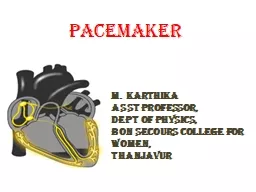

Dept of Physics Bon Secours College FOR WOMEN Thanjavur PACEMAKER A pacemaker is a small device thats placed in the chest or abdomen to help control abnormal heart rhythms This device uses electrical pulses to prompt the ID: 934705
Download Presentation The PPT/PDF document "PACEMAKER M. KARTHIKA Asst Professor," is the property of its rightful owner. Permission is granted to download and print the materials on this web site for personal, non-commercial use only, and to display it on your personal computer provided you do not modify the materials and that you retain all copyright notices contained in the materials. By downloading content from our website, you accept the terms of this agreement.
Slide1
PACEMAKER
M. KARTHIKA
Asst Professor,
Dept of Physics,
Bon Secours College
FOR WOMEN,
Thanjavur
Slide2PACEMAKER????
A pacemaker
is a small device that's placed in the chest or abdomen to help control abnormal
heart
rhythms. This device uses electrical pulses to prompt the heart to beat at a normal rate.
Slide3CARDIAC PACEMAKER
Slide4WORKING OF PACEMAKER
Slide5Heart Rhythm
SINUS RHYTHM
The normal cardiac rhythm is called sinus rhythm.
ARRHYTHMIA
Change in normal sinus rhythm is called Arrhythmia.
BRADYCARDIA
Heart blocks occur when the conduction system b/w atria and ventricles fails. If the blockage is not complete some impulses get through from atria but the heart rate will fall.(slow heart rate)
Slide6Types of H
eart blocksThere are three basic types of AV nodal block:First-degree AV block.
Second-degree AV block. Type I second-degree AV block (
Mobitz
I), also known as Wenckebach block. Type 2 second-degree AV block (Mobitz
II) - due to a block in or below the bundle of His.Third-degree AV block (complete heart block)
Slide7The bundle of His
The bundle of His is an important part of the electrical conduction system of the heart, as it transmits impulses from the atrioventricular node, located at the anterior-inferior end of the interatrial
septum
, to the ventricles of the heart.
Slide8Brief History of Pacemakers
Slide9PARTS OF PACEMAKER
Slide10OUTPUT REQUIREMENTS & ELECTRODES
RECTANGULAR PHASE
1mS
10mA
RESISTANCE 500 OHM
POWER= I*I*R
AVERAGE POWER= 50 MICROWATT
Pt, Ag, titanium, stainless steel electrodes
Slide11TYPES OF PACEMAKERS
Slide12CATEGORIES OF PACEMAKER
Slide13TYPICAL PACEMAKER
Slide14HEART WAVEFORMS
Slide15COMPETITIVE PACEMAKER
More-recent devices are
synchronous
, or demand,
pacemakers that trigger heart contractions only when the normal beat is interrupted. Most pacemakers of this type are designed to generate a pulse when the natural heart rate falls below 68 to 72 beats per minute.
Slide16NON-COMPETITIVE
Non
-
Competitive
Atrial Pacing (NCAP) is intended to prevent triggering of
atrial tachycardias by delaying the scheduled atrial pace from occurring within the atrium's relative refractory period.
Tachycardias
– FAST HEART BEAT RATE
Slide17THANK YOU